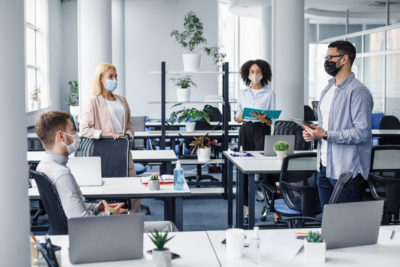 Now that vaccines, test kits, and COVID-19 treatments are more readily available and COVID-19 variants are becoming less severe, people have begun the return to office and to normal operations as part of what many are calling a “post-pandemic” world. Yet the pandemic isn’t actually over, and it’s likely that the world will have to live with the coronavirus and its variants for years to come.
Now that vaccines, test kits, and COVID-19 treatments are more readily available and COVID-19 variants are becoming less severe, people have begun the return to office and to normal operations as part of what many are calling a “post-pandemic” world. Yet the pandemic isn’t actually over, and it’s likely that the world will have to live with the coronavirus and its variants for years to come.
Nonetheless, more and more companies are asking employees to resume in-person work, which is why it’s essential to do so safely and thoughtfully, with their concerns in mind. The transition process works best when leaders design return-to-office plans in partnership with frontline workers, rather than making top-down decisions without employee support. Surveys, focus groups, and ad hoc committees are all important methods to gather feedback and facilitate partnership around the transition. Here’s how to prepare your workplace and employees for a safe return to the office.
- Decide on a vaccination policy. Naturally, this can be a difficult decision depending on the culture of your state, community, industry, and more. Weigh the pros and cons of your vaccination policy before implementing it and have a plan for seeing it through. If you’re concerned about resistance or negative office politics, you can always choose to simply follow CDC guidelines.
- Facilitate increased social distancing. Separate desks and workstations as much as possible. Limit the number of people in each space at a given time. Consider implementing a masking policy for when crowding cannot be avoided, such as in elevators. It may also be helpful to stagger break and lunchtimes to avoid crowding in the break room, since no one can eat or drink through a mask.
- Ensure proper function or upgrade of the air ventilation system. Because COVID-19 is spread primarily through the air, it’s essential to be sure that your workplace ventilation system is functioning properly, routinely serviced, and has its filters changed regularly. If your workspace doesn’t allow for consistent social distancing or masking, consider upgrading to a more powerful system that can significantly reduce pathogens in the airflow. You can find more resources on this here.
- Consider providing hand sanitizer in common areas. Adding hand sanitizer to the office budget does involve a small expense. However, it can pay off in a big way by reducing employee sick time and lost productivity—for illnesses caused by many viruses and bacteria, not just COVID-19. Employees will likely also appreciate your efforts to keep them in good health, especially if it means they don’t have to buy as much of their own sanitizer. Be sure that hand soap is well stocked at all sinks as well.
- Establish cleaning and disinfection protocols. Ensure that workspaces in the building—especially high-touch surfaces like doorknobs and doors, sink taps, and desktops—are disinfected regularly. This is best done by establishing a cleaning schedule that indicates which areas and surfaces to prioritize. Consider keeping disinfectant wipes in central locations for general employee use.
- Review and revise sick and work-from-home policies as needed. If at all possible, consider allowing employees to work from home on at least some workdays. Update your sick leave policy to comply with CDC COVID-19 guidelines and establish clear instructions for what employees should do if they test positive for COVID-19. These should also include whether workers will be expected to work at home while in quarantine, if applicable, and when they should return to work in person.
- Clearly communicate any new COVID-19 policies to all staff. Once you’ve prepared the physical workspace and all pandemic-related policies, communicate them to all employees before they return to work. Be sure to designate and refer workers to a contact person for any related questions or concerns. Consider creating a form that outlines the updated policies and requiring employees to sign it before their return to in-person work.
After more than two years, returning to the office is a big transition. Putting workers at the center, and prioritizing mental health, will set your organization up for success.
Ensure a Safe Return to Work with the National Fund for Workforce Solutions
The National Fund for Workforce Solutions invests in a dynamic national network of communities tackling critical workforce issues. To achieve our vision of an equitable future where workers, employers, and communities thrive and prosper, we equip workers for success.
From training, upskilling, and coaching to worker engagement, satisfaction, and well-being, we promote the full range of skills development and supports that enable workers to thrive. We recognize the humanity of workers and advance employer practices and workplace cultures that allow workers to show up as their full selves.
Learn more about what authentic worker voice and engagement looks like and subscribe to the National Fund email list to stay up to date with the latest in workforce development across the country.



